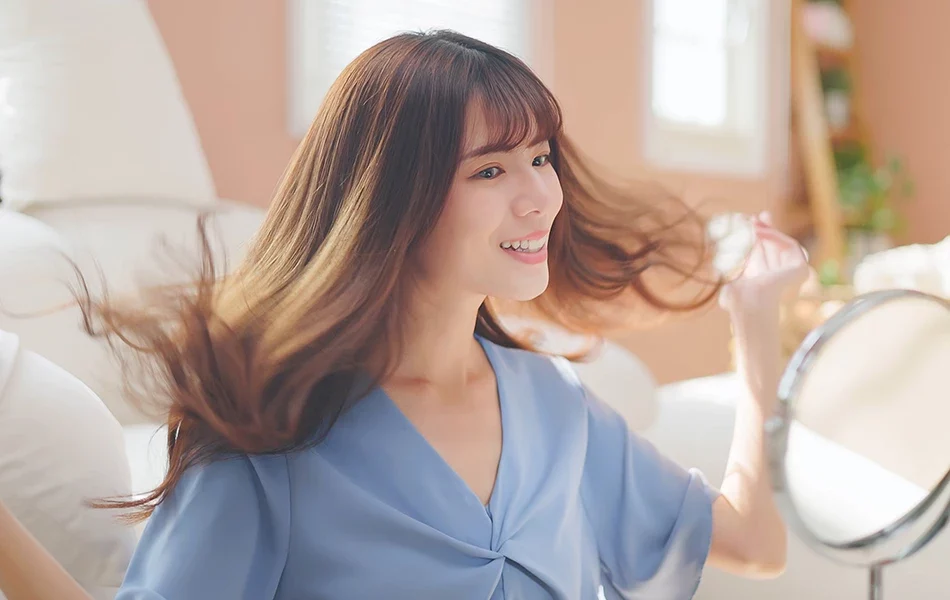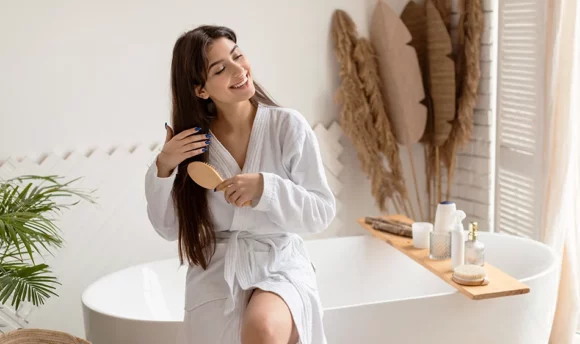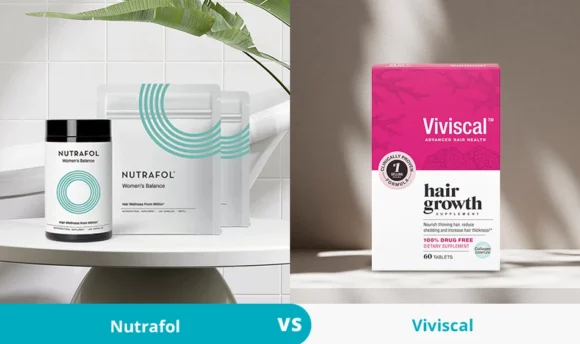Type 2a Hair (Wavy): Tips on How to Take Care and Style
The right haircare regimen will keep your hair looking its best, whatever your hair type. Want to know more about type 2a hair? Discover the pros and cons and unearth the secret to maintaining healthy 2a hair.

Hair care is complicated, with countless products, claims, styling tools, and methods to supposedly make your hair look its best. It’s no wonder people struggle with bad hair days when trying to navigate this world.
Fortunately, you can distinguish the most valuable assets and eliminate those that are no good by discovering your hair type. If you have loose, wavy tresses – chances are you’re a 2a hair type. If so, it’s time to start treating your hair appropriately for a full and healthy mane.
Keep reading to learn about hair type 2a, including its advantages, drawbacks, and the best styling tips.
What Is 2a Hair Type?
If you have type 2 hair, you fall into the wavy hair category, between type 1 hair (straight hair) and type 3 hair (curly hair). As a type 2a, your hair is the loosest of all the wavy hair types. The natural wave pattern is loose – it’s not quite straight, but it’s not defined waves, either. Picture low-density waves with a relaxed S-shape pattern.
Often, this hair type is straight at the root, with the waves forming somewhere in length. There is less definition and inconsistency in hair texture, so it can be difficult to identify this wavy hair type – especially if you haven’t used any products or tools to enhance the shape.
Pros of type 2a hair
Like every hair type, 2a has its benefits. There are many reasons to love 2a hair, especially if you can learn how to treat it with the care it deserves.
Here are 3 things that will leave other hair types envious of your locks:
#1 The best of both worlds
With 2a hair, you get the qualities of straight and wavy hair. Some days it might look wavier than others as the waves are gentle and subtle. Under the right conditions, you can enjoy beautiful, flowing beach waves without the maintenance required for more wavy and curly hair. That takes us to the next point.
#2 Low maintenance
Unlike its curly counterparts, 2a hair is very low maintenance. It’s naturally wavy and requires minimal effort to make it look good due to its light texture. Most people find it manageable, and a little product goes a long way to create those effortless, soft waves.
#3 It’s versatile
As this hair type doesn’t rely heavily on styling, you’re free to switch between wavy, straight, and curly hair to suit your mood. The natural texture is versatile, making it easy to style with the appropriate products, techniques, and hot tools when you want a change from loose waves.
Cons of type 2a hair
Of course, 2a hair types have a downside. Nobody’s hair is perfect, and a strong haircare routine is usually enough to mitigate any problems. Still, it’s good to know the negative side so you know how to take action when dealing with a bad hair day.
#1 Lack of definition
As mentioned, 2a hair falls somewhere in between straight and wavy hair. This has perks, but the poor definition can leave some wavy strands looking lackluster. It doesn’t have the same natural volume or thickness as the more dense or highly-defined, tight waves of 2b and 2c hair types.
#2 Flat roots
The slight wave pattern typically appears from about eye level. With straight roots and all of the body in length and the ends, there is a certain flatness to type 2a hair and a lack of volume compared to other hair types. You may need volumizing products to uplift your hair’s crown.
#3 Prone to breakage
This type of wavy hair is usually fine hair, which is why it struggles to form more definitive waves. The problem with fine hair is that it’s more fragile and vulnerable than coarse hair types. Unfortunately, this means it is more prone to tangling, breakage, and split ends.
Brushing frequently and overusing hot tools to transform your natural waves into more exciting styles will also cause damage to the hair shaft. Limiting surface damage is essential if you want your 2a hair to remain healthy.
How to Take Care of Type 2a Hair?
Some simple dos and don’ts will help you maintain your wavy hair and keep it naturally tousled with little to no work. Just keep the following tips in mind when caring for this hair type.
#1 Don’t wash your hair daily
It might be tempting to wash your hair every day when you notice flatness at the roots. However, shampooing daily will remove your scalp’s natural oils that it needs to stay healthy. Moreover, overwashing your hair can send your scalp’s oil production into overdrive. As people with type 2a hair already battle with an oily scalp, this might worsen the problem.
#2 Do detangle
Hair with a wavy texture is more prone to tangling, so you must detangle your strands before styling. Using a wide tooth comb or a gentle boar bristle brush on damp hair helps to remove tangles without harming the natural waves. You can also detangle your hair in the shower with your fingers to avoid any breakage.
#3 Do use volumizing products at the roots
A volumized mane might be one of your biggest hair goals as a person with 2a hair. The right products can help you tackle volume issues as they work by building body and texture at the roots. Using a blow dryer underneath the roots can also help, but if you want a non-heat technique, rollers can create all the root volume you desire.
#4 Don’t use heavy products
Heavy products are great for those with thick and well-defined curls but can quickly weigh down finer hair types. You’re better off using lightweight items, like serum or a curl-enhancing cream, to define your wave patterns without causing product build-up, a greasy appearance, or your waves to fall flat.
#5 Don’t use too much heat
It can be appealing to restyle your type 2a hair, shifting between straight and curly.
Unfortunately, this can do a lot of damage. Heat exposure damages the hair shaft, changes texture, and reduces elasticity. It also alters your hair’s natural wave or curl pattern, so your hair might come out pretty straight after blow-drying.
Allowing your hair to air dry when possible will help your waves form better. It also helps the hair retain moisture better; otherwise, towel drying with a microfiber towel is the best way to dry hair.
With that in mind, try to limit how often you apply heat to your hair throughout the week, whether from a blow dryer, curling iron, or hair straighteners. And when you do, always use a heat protectant to build a protective barrier.
#6 Do get regular trims
Regularly removing the dead ends supports a healthy environment for your hair to thrive. A haircut immediately makes your hair look and feel good because it eliminates those thin, tangled, straggly ends, creating the illusion of thicker tresses.
While cutting your hair won’t directly result in faster hair growth, it can stop your hair from breaking off and slowing the process.
What Haircuts Are Perfect for Type 2a Hair?
The great thing about having type 2a hair is that you can style it in multiple ways. There aren’t many limits to what you can and can’t do in the salon – perfect for those who like to mix things up. But if you’re not sure where to begin, here are 3 great haircuts to try:
#1 Shoulder-length
A shoulder-length cut is a great length for this type of hair. Your waves can thrive as they remain shapely without becoming dry and raggy on the ends. It doesn’t require half as much upkeep as longer hair, and it’s a flattering style that will look good on anybody.
#2 Pixie cut
A pixie cut is a stylish cut for wavy hair textures. It benefits finer follicles because it adds extra texture, making your hair appear thicker and more voluminous. It might require frequent trips to the hair salon, but everyday styling is quick and stress-free.
#3 Bob cut
A bob is a classic, short to medium-length cut. Again, this is a low-maintenance style that your stylist can customize to fit the shape of your face and bring out your features. Additional layering increases the volume to ensure your waves are never looking lifeless.
Best Products and Ingredients for 2a Type Hair
Now you know how to care for your unique hair type, you can start thinking about the most worthwhile products to work into your routine. Using the most beneficial ingredients can help you build a solid relationship with your hair, and you will soon learn to love your hair type.
Ingredients
Whether you’re looking for a shampoo, hair mask, or leave-in conditioner, some of the best ingredients for wavy hair center around those that lock in moisture and minimize frizz.
As type 2a hair tends to be flat, look for lightweight oils. Good examples include:
- Argan oil
- Avocado oil
- Jobajoba oil
- Grapeseed oil
Shampoos and other products
The Moérie Mineral Shampoo is an excellent choice if you want to bring out the best of your hair’s type. It contains natural origin ingredients that cleanse the scalp to remove product build-up while boosting growth for thicker, healthier hair.
Some other highly rated and recommended products are:
- Blue Atlas Shampoo
- Bumble and Bumble Seaweed Shampoo
- Morrocanoil Hydrating Shampoo
- OGX Moroccan Sea Salt Spray
- Shea Moisture Curl Mousse
FAQs
You can check which type of hair you have by assessing your hair strands. If you have wavy hair (not curls), you have type 2 hair. Type 2a hair has the loosest and lax waves of all type 2 hair types. It is straight from the roots and falls into gentle waves around eye level.
The key difference between type 2a and 2b hair is that 2a has lower-density and less-defined waves. The waves mimic a loose S-shape pattern, while 2b waves are more defined with medium density.
Type 2a hair is not a rare hair type. Many people have hair somewhere in the middle between straight hair and curls, and type 2a falls into this category.
A Word From an MD
People with type 2a hair have slight waves that form around the mid-length. The roots are straight for a few inches, and many individuals lack volume in this area. Other concerns are that it is likely to become oily at the roots, tangled, and more at risk of breaking.
It’s important to keep your scalp clean and free from residue. A healthy scalp benefits every hair type and significantly improves the condition of the overall hair shaft. It also allows your hair to grow at a healthy rate and prevents common problems like hair thinning and loss.
On the upside, it doesn’t require the same upkeep as curly and coily hair types. You can keep your hair healthy with some simple practices, like allowing your hair to air dry, applying moisturizing products, and limiting the use of the curling iron to enhance your curl patterns.
Conclusion
Type 2a is a unique hair pattern characterized by beautiful lax waves. While it is not a high-maintenance hair type, following a few tips will bring out the very best of your locks. Just let your hair dry naturally after washing to see how your natural waves fall into place.
You can try a curl cream or curl definer to boost your 2a hair without using a hot tool – a great way to diminish damage to those finer strands.

















































 Select your language:
Select your language: 








